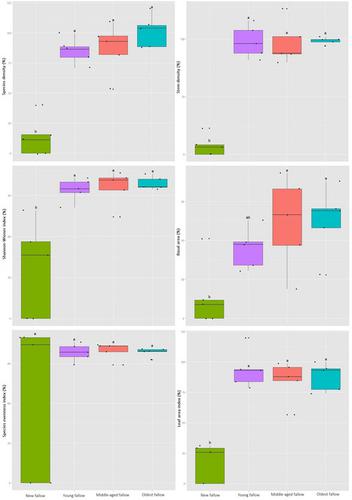当前位置:
X-MOL 学术
›
Ecol. Evol.
›
论文详情
Our official English website, www.x-mol.net, welcomes your
feedback! (Note: you will need to create a separate account there.)
Rapid recovery of tropical forest diversity and structure after shifting cultivation in the Philippines uplands.
Ecology and Evolution ( IF 2.3 ) Pub Date : 2020-06-05 , DOI: 10.1002/ece3.6419 Sharif A Mukul 1, 2 , John Herbohn 1, 2 , Jennifer Firn 3
Ecology and Evolution ( IF 2.3 ) Pub Date : 2020-06-05 , DOI: 10.1002/ece3.6419 Sharif A Mukul 1, 2 , John Herbohn 1, 2 , Jennifer Firn 3
Affiliation

|
Shifting cultivation is a widespread land‐use in the tropics that is considered a major threat to rainforest diversity and structure. In the Philippines, a country with rich biodiversity and high rates of species endemism, shifting cultivation, locally termed as kaingin, is a major land‐use and has been for centuries. Despite the potential impact of shifting cultivation on forests and its importance to many people, it is not clear how biodiversity and forest structure recover after kaingin abandonment in the country, and how well these post‐kaingin secondary forests can complement the old‐growth forests. We investigated parameters of forest diversity and structure along a fallow age gradient in secondary forests regenerating after kaingin abandonment in Leyte Island, the Philippines (elevation range: 445–650 m asl). We first measured the tree diversity and forest structure indices in regenerating secondary forests and old‐growth forest. We then measured the recovery of tree diversity and forest structure parameters in relation to the old‐growth forest. Finally, using linear mixed effect models (LMM), we assessed the effect of different environmental variables on the recovery of forest diversity and structure. We found significantly higher species density in the oldest fallow sites, while Shannon’s index, species evenness, stem number, basal area, and leaf area index were higher in the old‐growth forest. A homogeneous species composition was found across the sites of older fallow age. Multivariate analysis revealed patch size as a strong predictor of tree diversity and forest structure recovery after shifting cultivation. Our study suggests that, secondary forests regenerating after shifting cultivation abandonment can recover rapidly. Although recovery of forest structure was not as rapid as the tree diversity, our older fallow sites contained a similar number of species as the old‐growth forest. Many of these species are also endemic to the Philippines. Novel and emerging ecosystems like tropical secondary forests are of high conservation importance and can act as a refuge for dwindling tropical forest biodiversity.
中文翻译:

菲律宾高地轮耕后热带森林多样性和结构迅速恢复。
轮耕是热带地区广泛的土地利用方式,被认为是对雨林多样性和结构的主要威胁。在菲律宾,这个生物多样性丰富、物种特有率高的国家,轮耕(当地称为 kaingin)是一种主要的土地利用方式,已有数百年历史。尽管轮耕对森林有潜在影响及其对许多人的重要性,但目前尚不清楚该国卡因废弃后生物多样性和森林结构如何恢复,以及这些后卡因次生林如何补充原始森林。我们调查了菲律宾莱特岛卡因废弃后再生的次生林的休耕年龄梯度的森林多样性和结构参数(海拔范围:445-650 m asl)。我们首先测量了再生次生林和古老林的树木多样性和森林结构指数。然后,我们测量了与原始森林相关的树木多样性和森林结构参数的恢复情况。最后,利用线性混合效应模型(LMM),我们评估了不同环境变量对森林多样性和结构恢复的影响。我们发现最古老的休耕地的物种密度明显更高,而原始森林的香农指数、物种均匀度、茎数、断面积和叶面积指数则更高。在较老的休耕期地点发现了同质的物种组成。多变量分析表明,斑块大小是轮耕后树木多样性和森林结构恢复的有力预测因素。我们的研究表明,轮耕废弃后再生的次生林可以迅速恢复。 尽管森林结构的恢复不如树木多样性那么快,但我们较古老的休耕地包含与古老森林相似数量的物种。其中许多物种也是菲律宾特有的。像热带次生林这样的新兴生态系统具有很高的保护重要性,可以作为日益减少的热带森林生物多样性的避难所。
更新日期:2020-07-30
中文翻译:

菲律宾高地轮耕后热带森林多样性和结构迅速恢复。
轮耕是热带地区广泛的土地利用方式,被认为是对雨林多样性和结构的主要威胁。在菲律宾,这个生物多样性丰富、物种特有率高的国家,轮耕(当地称为 kaingin)是一种主要的土地利用方式,已有数百年历史。尽管轮耕对森林有潜在影响及其对许多人的重要性,但目前尚不清楚该国卡因废弃后生物多样性和森林结构如何恢复,以及这些后卡因次生林如何补充原始森林。我们调查了菲律宾莱特岛卡因废弃后再生的次生林的休耕年龄梯度的森林多样性和结构参数(海拔范围:445-650 m asl)。我们首先测量了再生次生林和古老林的树木多样性和森林结构指数。然后,我们测量了与原始森林相关的树木多样性和森林结构参数的恢复情况。最后,利用线性混合效应模型(LMM),我们评估了不同环境变量对森林多样性和结构恢复的影响。我们发现最古老的休耕地的物种密度明显更高,而原始森林的香农指数、物种均匀度、茎数、断面积和叶面积指数则更高。在较老的休耕期地点发现了同质的物种组成。多变量分析表明,斑块大小是轮耕后树木多样性和森林结构恢复的有力预测因素。我们的研究表明,轮耕废弃后再生的次生林可以迅速恢复。 尽管森林结构的恢复不如树木多样性那么快,但我们较古老的休耕地包含与古老森林相似数量的物种。其中许多物种也是菲律宾特有的。像热带次生林这样的新兴生态系统具有很高的保护重要性,可以作为日益减少的热带森林生物多样性的避难所。











































 京公网安备 11010802027423号
京公网安备 11010802027423号